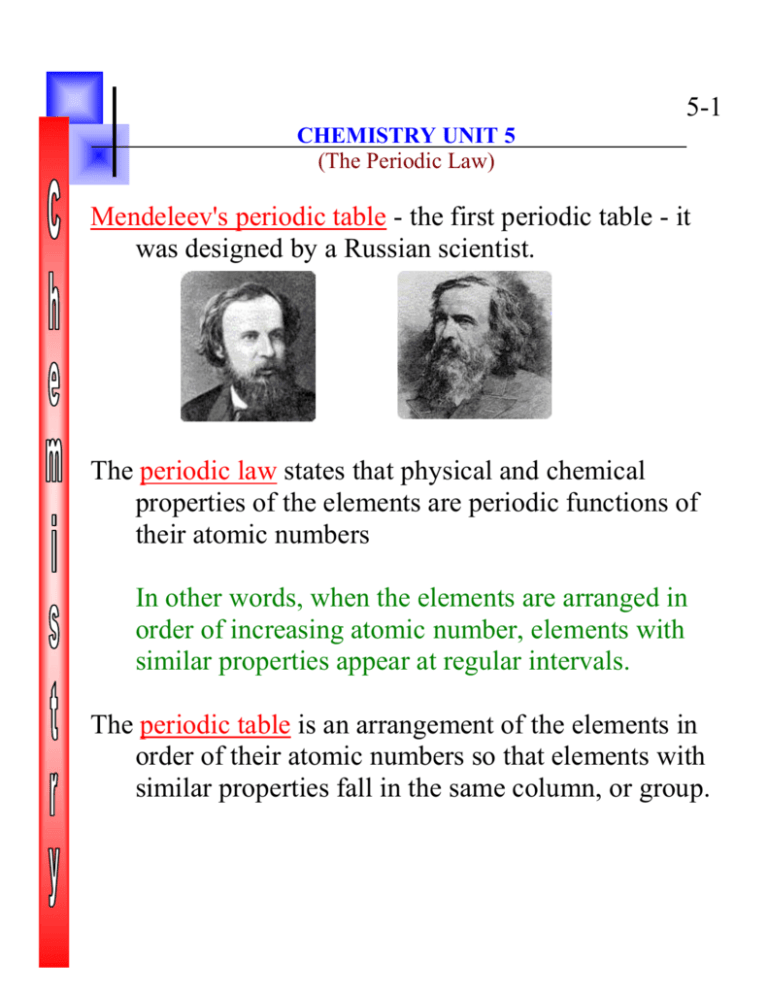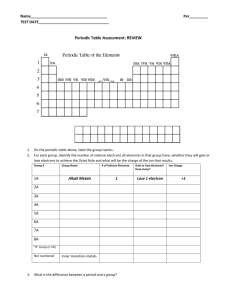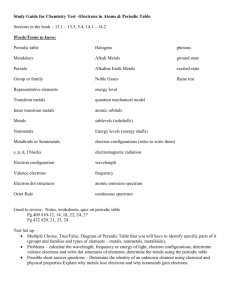Chapter 5 The Periodic Law
advertisement

5-1 CHEMISTRY UNIT 5 (The Periodic Law) Mendeleev's periodic table - the first periodic table - it was designed by a Russian scientist. The periodic law states that physical and chemical properties of the elements are periodic functions of their atomic numbers In other words, when the elements are arranged in order of increasing atomic number, elements with similar properties appear at regular intervals. The periodic table is an arrangement of the elements in order of their atomic numbers so that elements with similar properties fall in the same column, or group. 5-2 Elements within the same families have similar properties Group I Sodium Family (Alkali Metals) most active metals has 1 electron in the highest energy level charge of +1 Group II Calcium Family (Alkaline Earth Metals) active metals has 2 electrons in the highest energy level charge of +2 Group III Boron Family composed of nonmetals and metals has 3 electrons in the highest energy level charge of +3 Group IV Carbon Family composed of non-metals and metals has 4 electrons in the highest energy level charge of +4 or -4 5-3 Group V Nitrogen Family composed of non-metals and metals has 5 electrons in the highest energy level charge of -3 Group VI Oxygen family mostly active nonmetals has 6 electrons in the highest energy level charge of -2 Group VII Halogens most active nonmetals has 7 electrons in the highest energy level charge of -1 Group VIII Noble gases inert (will not react) has 8 (octet) electrons in the highest energy level except He which has 2 charge of 0 5-4 Transition elements are metals, which have properties that are not shared by any other groups of elements The rare earth elements are made up of the lanthanide and actinide series 5-5 An ion is an atom or group of atoms that has a positive or negative charge An ion is formed when a neutral atom loses or gains one or more electrons 5-6 Ionization energy IE is the energy required to remove one electron from a neutral atom + Ex: A + energy A + electron Each time an additional electron is move away from an atom, larger amounts of energy is required. Thus the 2nd ionization energy is higher than the 1st and so on. Low ionization energy is characteristic of a metal (metals give up electrons easily) High ionization energy is characteristic of a nonmetal (non-metals don't give up electrons easily) Electron affinity is the energy change that occurs when an electron is acquired by a neutral atom Ex: A + electron --> A + energy F + electron --> F + energy A positive ion is know as a cation. A negative ion is know as an anion. 5-7 Valence electrons are those available to be lost, gained, or shared in the formation of compounds. Electronegativity is a measure of the ability of an atom in a chemical compound to attract electrons. Tendencies of the Periodic Chart








